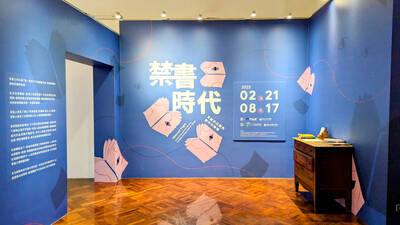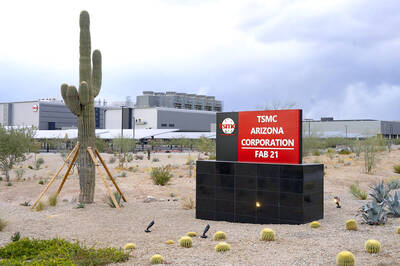Ellen Mackey circles the paradise of drought-tolerant plants edging her model eco-home and pauses before its electric meter, triumphant.
Its wheel is turning backward — her 36 rooftop solar panels injecting juice back into the city’s power grid.
“I use so little electricity the DWP [Department of Water and Power] tells me I’m one of their worst customers,” said Mackey, 57, of Sun Valley, California. “If every LA homeowner set up solar ... we could severely limit our use of electricity, reduce fossil fuels, limit global warming and stop giving money to people who hate us.”
Back on April 22, 1970, the ecologist had joined 20 million Americans in a grass-roots call for environmental action they named Earth Day. They were angry that acid rain fell in the East, rivers burned in the Midwest, and Los Angeles choked beneath a thick brown blanket of smog.
Mackey joined a projected 1 billion people around the world yesterday for an Earth Day rally to safeguard Mother Earth.
Nearly 40 years after the first widespread call for environmental protection helped spawn a tangle of regulations against pollution, the air looks cleaner,
the waters appear bluer and the roads seem to draw less litter.
But despite such gains — and a global consciousness gone green — many scientists say the planet is in jeopardy. Oceans are sick. Forests are clear-cut. And plant and animal species face extinction from climate change and a critical loss of habitat.
“We all agree that we’re in much worse shape than in 1970,” said Kathleen Rogers, president of the Earth Day Network, the group that organized Earth Day.
“We’ve cleaned up the stuff we can see. But it’s the stuff we can’t see — particulates in the air, toxins, the impact of persistent organic pollutants that turn male fish into female fish — that are more prevalent.
“We have a major battle ahead of us.”
‘ONE PERSON AT A TIME’
Earth Day festivals in the San Fernando Valley at the weekend featured attractions from yogis to zero-emissions cars.
But can individual contributions like curbside recycling, canvas shopping bags or native plants help avert a pending environmental cataclysm?
“It takes one person at a time,” said Stephanie Lallouz, producer of the Topanga Earth Day Festival. “It’s an awakening.”
Flashback to 1970.
Protests against the Vietnam War spilled over to outrage about industrial pollution: Oil that fouled Santa Barbara beaches. Bald eagles threatened by DDT. The Cuyahoga River in Cleveland again aflame.
In response, US Senator Gaylord Nelson proposed Earth Day, the first nationwide environmental protest. A modern green movement was born.
“It sounds as if the land has gone mad, and in a way some of it has — mad at man’s treatment of his environment,” said Life magazine following the first Earth Day event.
The green-flag event helped launch the Environmental Protection Agency and passage of the Clean Air, Clean Water and Endangered Species acts.
Since then, the smog alert has largely vanished from Los Angeles.
But environmental action did not, necessarily, make for an entirely healthier environment.
Global warming, habitat loss and hunting put one out of four mammals — including the Tasmanian devil — at risk of extinction by the end of this century, according to a 2008 report by the International Union for Conservation of Nature.
In addition, overfishing and acidification of the seas threaten coral reefs and marine species such as the Chinook salmon. Dead zones now lurk off the West Coast.
“In many ways, things have gotten better, in many ways, they’ve gotten worse,” said Ashwani Vasishth, professor of urban planning at California State University, Northridge, and founder of the year-old Institute for Sustainability.
While Southern California’s air is visibly cleaner, with fewer extremely smoggy days, Vasishth said that overall particulate levels have increased.
“What we call pollution is shifting,” he said. “How we measure harm to the environment is changing. We’re better informed. We’re more aware of our risks.
“If there’s one thing we need to be concerned about, it’s climate change. We’re running out of water, we’re running out of arable fertile land, of topsoil, we’re running out of carrying capacity of our oceans. We’ve been losing species at an accelerated rate.”
In 1970, the Earth was home to 3.7 billion people; today, there are 6.7 billion, an 80 percent increase. In the same period, the US population grew from
205 million to 306 million, while California’s
population nearly
doubled to 40 million.
Meanwhile, climate change has boosted the average Earth temperature by 0.7° C, enough to melt polar ice caps and raise the sea level 7.6cm.
Carbon dioxide, a greenhouse gas blamed for global warming, has increased 18 percent. The impact of climate change, according to federal environmental regulators, ranges from drought to floods to more intense storms, in addition to harming water resources, agriculture, wildlife and ecosystems.
“It’s the population, it’s killing us,” said Bill Patzert, a research oceanographer at NASA’s Pasadena-based Jet Propulsion Laboratory, who for a decade has lectured on the dangers of climate change. “We’re worse off than we were before.
“The bottom line is that, in spite of all the good intentions of Earth Day — and all the do-gooders like me — we’ve dug ourselves into a deeper hole than we were in 40 years ago.”
Rogers, of Earth Day Network, says it’s incumbent upon the environmental and corporate communities to invest in green technology.
“We all need to become political,” she said. “I believe in volunteerism, but 99 percent of Earth Day is civic action, it’s public policy. It’s getting out there and telling other people in charge, ‘We’re not going to put up with it any more.’
“Because of climate change, we don’t have the luxury of sitting around anymore as citizens and waiting for something to happen.”
NOT A MOMENT TOO SOON
Mackey and her daughter, Alexia, weren’t about to wait before transforming their 1950s tract house into a model eco-home.
Ellen Mackey was 19 when she demonstrated in the 1970 Earth Day in Haverhill, Massachusetts.
“We didn’t know what to do,” she said. “So we picked up trash. We talked about whales. About clean water. Clean air. Pollution. Healthy issues.
“We wanted to change the world, to make a difference. I guess I never grew up. I still believe that one person can make a difference — that I, and my daughter, can make a difference.”
Mackey, now a senior ecologist for the Metropolitan Water District, has co-authored a book on Southern California’s native plant gardens. She’s also a past president of the Theodore Payne Foundation of Sun Valley and the Eco-Home Network of Silver Lake.
When she bought her 1950s home 12 years ago, her first water and electricity bill was US$238.
That was before she converted the 167m² house on a suburban cul-de-sac to an affordable-energy and water-conservation home.
First came the US$17,000 solar energy system — funded by a 70 percent rebate from the Department of Water and Power.
Then came US$10,000 in double-pane windows. Nearly US$1,700 in insulation in the attic, walls and floor. And a host of personal touches, including a recycled glass-and-granite countertop, composite wood hot tub deck and a needlepoint that reads “Reduce Reuse Repair Recycle.”
Outside her home is an extensive low-water garden that includes native flowers like purple sage interspersed with organic foods like tomatoes, blackberries and crook-neck squash.
Today, her highest utility bills are US$70 for two months of winter heat. In summer, she employs a swamp cooler, but pays no power bill. When it’s 37.7° C outside, it’s a temperate 23.8° C inside.
“We have a planetary problem,” said Mackey, standing next to a barrel used to catch rainwater. “We need people to know they can do this, on their budget, reducing their consumption of water and electricity.
“It’ll make a difference, to the state, to the nation, all the way to the polar bears ... You have to believe you can make a change.
“Or you’d give up.”

On the final approach to Lanshan Workstation (嵐山工作站), logging trains crossed one last gully over a dramatic double bridge, taking the left line to enter the locomotive shed or the right line to continue straight through, heading deeper into the Central Mountains. Today, hikers have to scramble down a steep slope into this gully and pass underneath the rails, still hanging eerily in the air even after the bridge’s supports collapsed long ago. It is the final — but not the most dangerous — challenge of a tough two-day hike in. Back when logging was still underway, it was a quick,

From censoring “poisonous books” to banning “poisonous languages,” the Chinese Nationalist Party (KMT) tried hard to stamp out anything that might conflict with its agenda during its almost 40 years of martial law. To mark 228 Peace Memorial Day, which commemorates the anti-government uprising in 1947, which was violently suppressed, I visited two exhibitions detailing censorship in Taiwan: “Silenced Pages” (禁書時代) at the National 228 Memorial Museum and “Mandarin Monopoly?!” (請說國語) at the National Human Rights Museum. In both cases, the authorities framed their targets as “evils that would threaten social mores, national stability and their anti-communist cause, justifying their actions

In the run-up to World War II, Admiral Wilhelm Canaris, head of Abwehr, Nazi Germany’s military intelligence service, began to fear that Hitler would launch a war Germany could not win. Deeply disappointed by the sell-out of the Munich Agreement in 1938, Canaris conducted several clandestine operations that were aimed at getting the UK to wake up, invest in defense and actively support the nations Hitler planned to invade. For example, the “Dutch war scare” of January 1939 saw fake intelligence leaked to the British that suggested that Germany was planning to invade the Netherlands in February and acquire airfields

Taiwanese chip-making giant Taiwan Semiconductor Manufacturing Co (TSMC) plans to invest a whopping US$100 billion in the US, after US President Donald Trump threatened to slap tariffs on overseas-made chips. TSMC is the world’s biggest maker of the critical technology that has become the lifeblood of the global economy. This week’s announcement takes the total amount TSMC has pledged to invest in the US to US$165 billion, which the company says is the “largest single foreign direct investment in US history.” It follows Trump’s accusations that Taiwan stole the US chip industry and his threats to impose tariffs of up to 100 percent